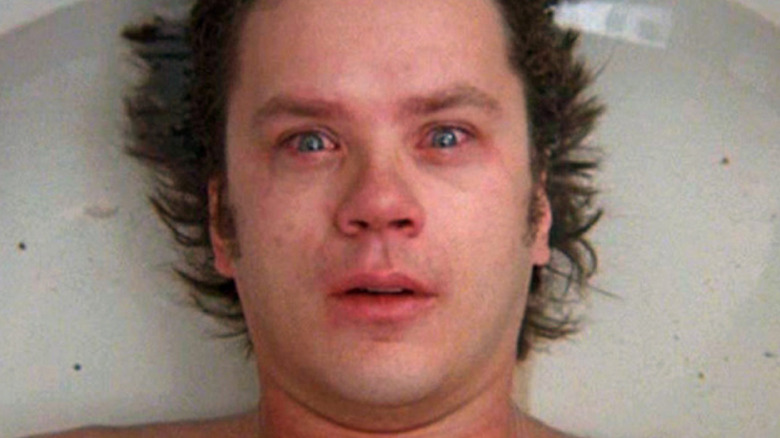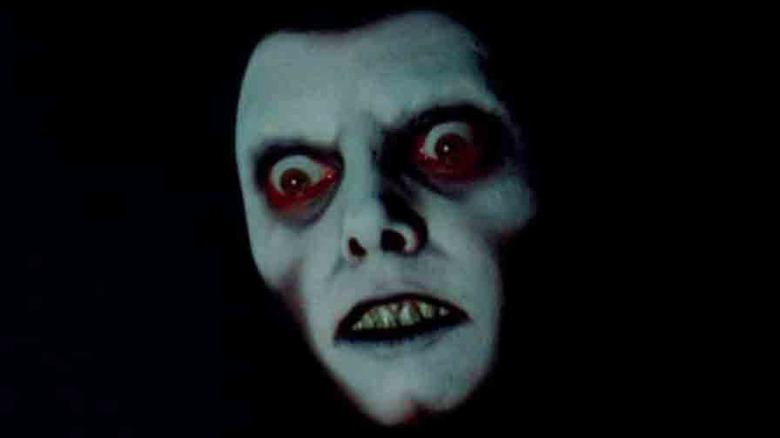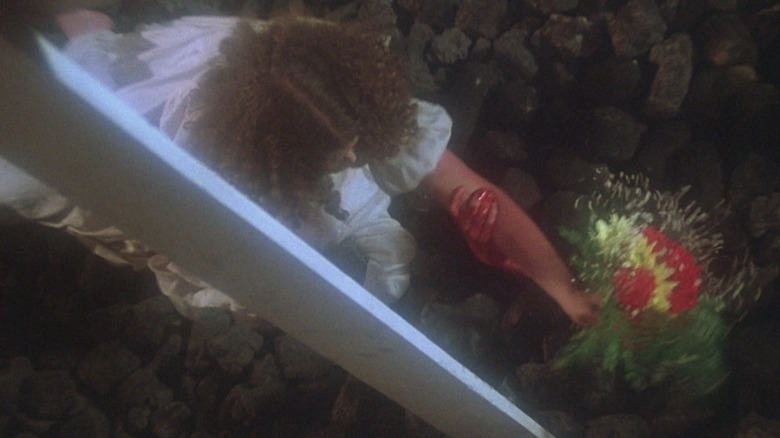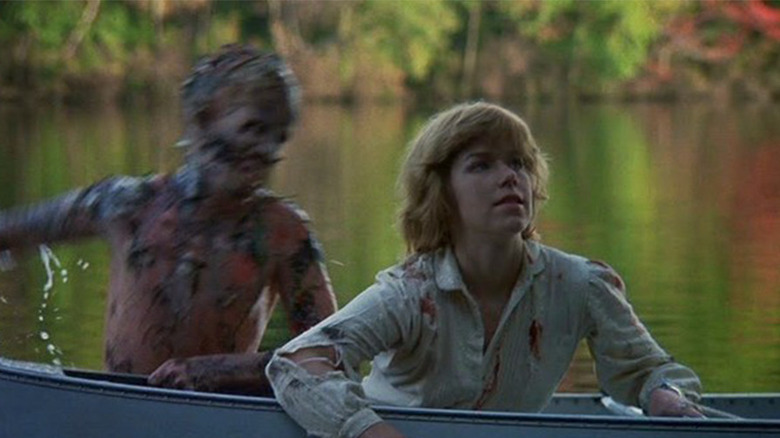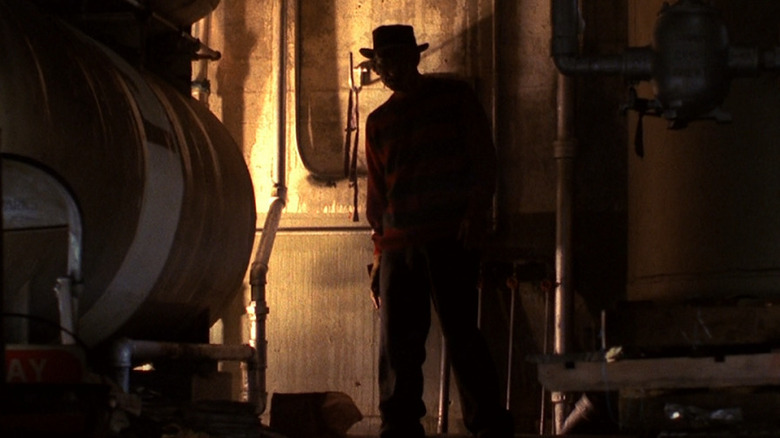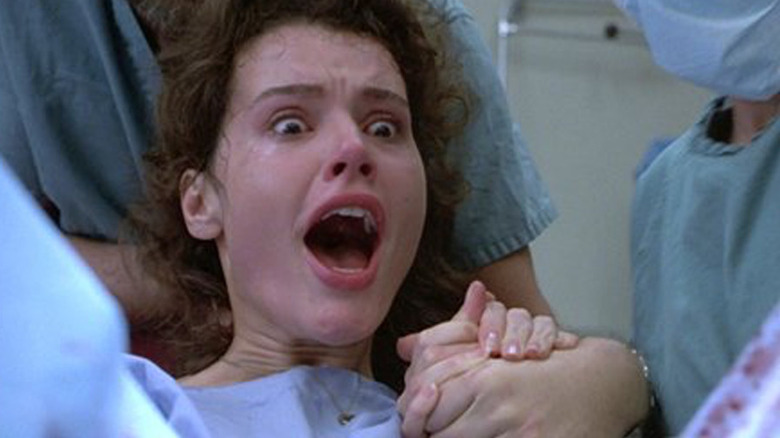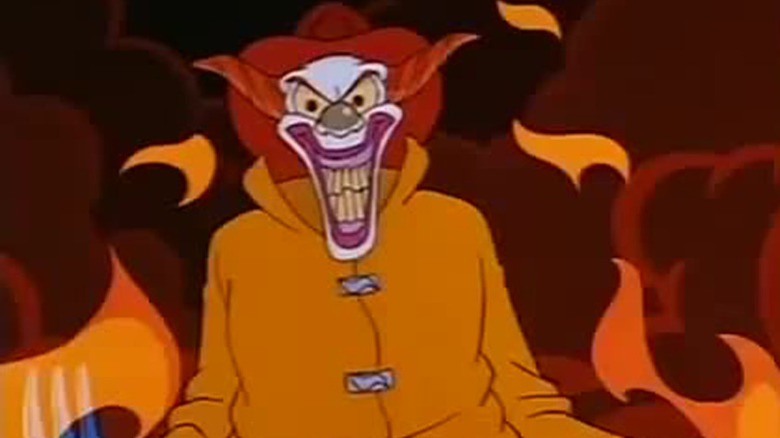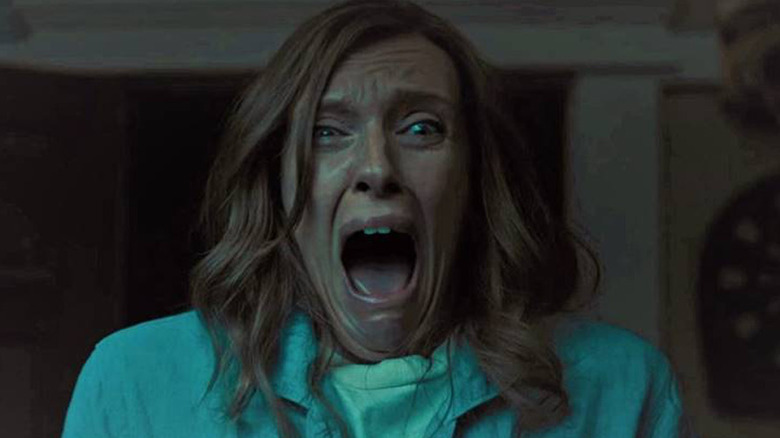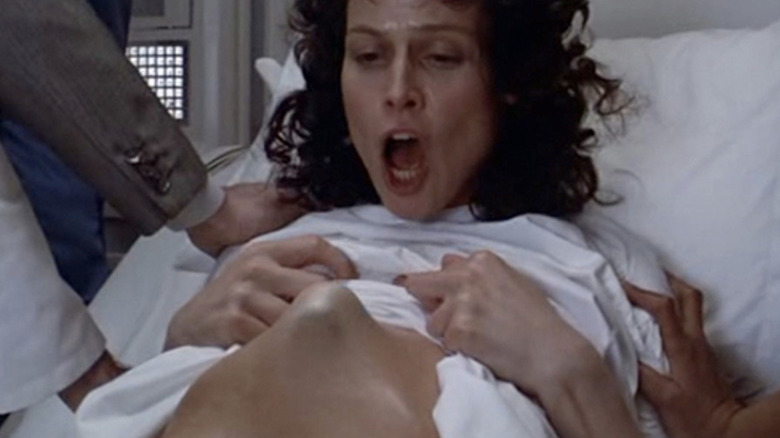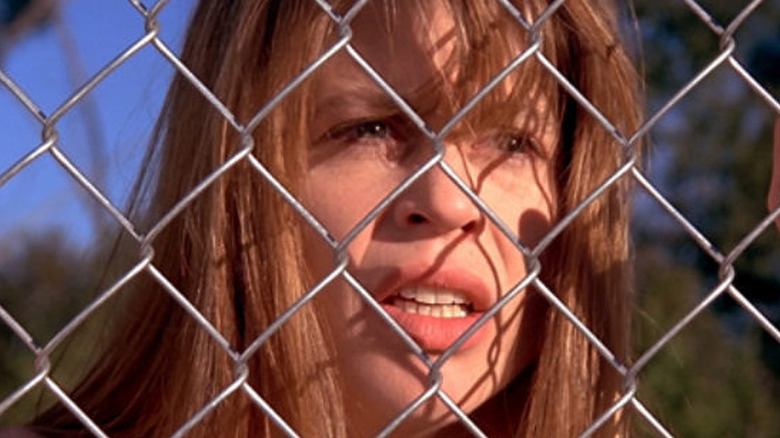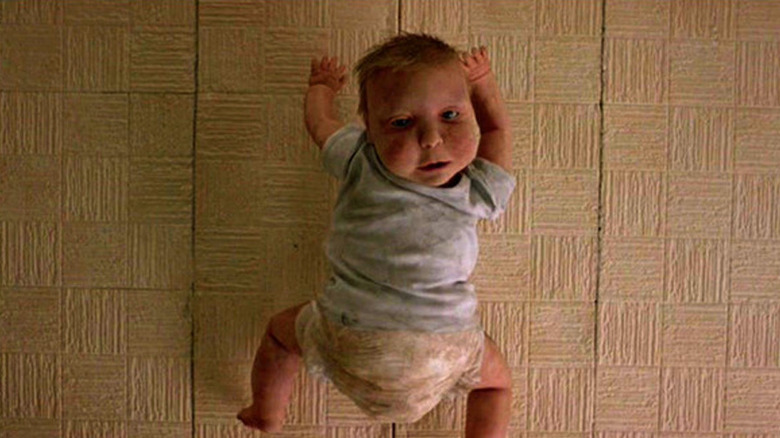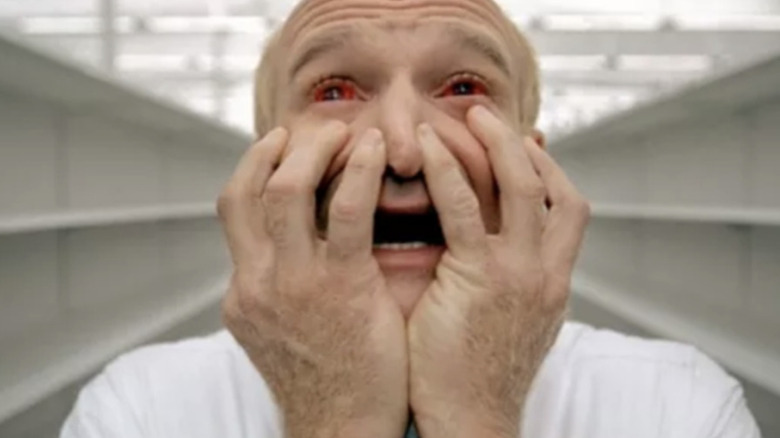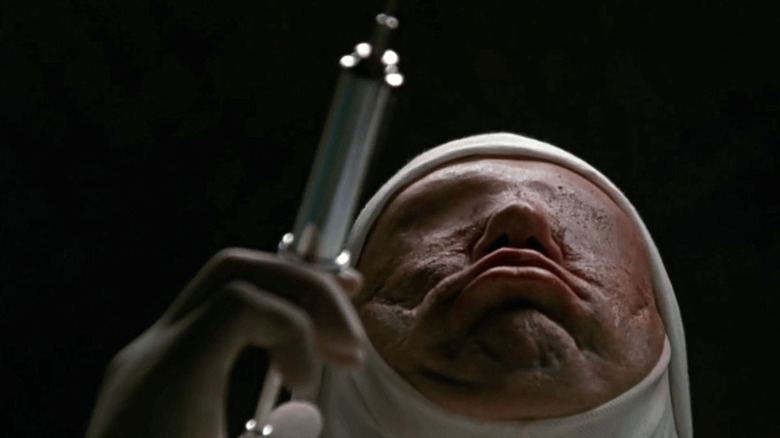The Creepiest Dream Sequences In Movies
It's not uncommon for the imagery seen in films to affect us in our dreams, hence the term nightmare fuel. But what happens when a film takes it a step further and showcases a character's literal nightmare right there on the screen? What has emerged from this trope is a treasure trove of disturbing instances of cinematic renditions of psychosis and mind-boggling imagery. It could be the result of a character's mental state or created by the powers of an evil supernatural force, but it's chilling either way.
Even more fascinating is that the film in question doesn't need to be from the horror genre to be disturbing. Oftentimes action films, dramas, thrillers, and animated family films can be surprising sources for disturbing dream scenes. Regardless of genre boundaries, these also are the scenes that had the characters, and by proxy the audience, sweating in their sheets. So sit back, relax and resist the lure of slumber as we look at the creepiest dream sequences in movie history.
The Exorcist -- the face of Pazuzu
Since its 1973 release, "The Exorcist" has been widely regarded as one of the scariest movies of all time. Even when viewed today the film hasn't lost its original visceral impact and troublesome implications about heaven and hell. This can be attributed to William Friedkin's stellar direction and an utterly terrifying performance from a young Linda Blair as little Regan. The film also boasts a bone-chilling soundtrack and some of horror cinema's most memorably sickening special effects. Due to the film's themes, which touch on the psychological and spiritual, dreams play a massive role throughout.
Most notable is a dream sequence in which Father Karras (Jason Miller) sees his recently deceased mother descend a flight of subway stairs. This is meant as a metaphor for her damnation, something Regan later mocks Father Karras for during the exorcism. While she descends the stairs in silence, we see a brief flash of a horrific white face. It is only on screen for what seems to be a fraction of a second, but definitely leaves an impact. In actuality the shot in question was repurposed makeup test footage of Blair's body double, Eileen Dietz. Regardless of its origins, it still stands as one of the most haunting visuals ever shown on the big screen.
Carrie -- the final jump scare
Ending a film on a dream sequence is a bold move, and if done improperly can quite possibly leave an audience annoyed as they walk out. But when it's done correctly, the sequence can be an utterly disturbing note to conclude the film with. Case in point, the bizarre and truly disturbing final moments that close out the original "Carrie."
After her violent telepathic escapades at her school's prom, Carrie White (Sissy Spacek) returns home to wash off the blood and recuperate. The latter is made impossible when her mother (Piper Laurie), luring her in with a hug, attempts to stab Carrie to death. In response, Carrie eliminates her with her telepathy and several kitchen blades, then proceeds to bring down her own house. Following this, the only person to survive Carrie's rampage — Sue Snell (Amy Irving) — approaches her now-destroyed home. Sue's walk to Carrie's house is made even creepier by the footage having been filmed backwards then reversed. The off-putting serenity of the scene is torn asunder when Carrie's bloody hand erupts from the ground and grabs Sue. This results in Sue awakening from this nightmare, crying and screaming into her mother's arms as the film ends. A truly disturbing ending for one of the best adaptations of Stephen King's prolific bibliography.
Friday the 13th -- young Jason attacks
When you think of the slasher sub-genre, the "Friday the 13th" series comes to mind fairly quickly. Due to its memorable kills and dark sense of humor, the series has become a staple of the horror genre. This is due in no small part to its main protagonist, the machete-wielding hockey mask enthusiast Jason Voorhees. Given Jason's immense pop cultural significance, it's always worth pointing out that he wasn't intended to be the lead villain. Throughout the film Jason is presumed dead, having drowned due to the negligence of the Camp Crystal Lake counselors. Taking the role of antagonist in the series' inaugural film was Jason's mother, Mrs. Pamela Voorhees, played by Betsy Palmer.
Once Pamela meets her end at the hands of the film's final girl, Alice, all seems perfectly fine. Alice awakens the next morning in a boat, gently gliding on Crystal Lake as the authorities arrive on the shoreline. But, just as the calming music reaches an almost comical crescendo, a rotting young Jason erupts from the waters below. He drags a screaming Alice down to the depths, but suddenly Alice awakens in a hospital completely fine. It's often regarded as one of horror's most nightmare-inducing moments, and it's not hard to see why.
A Nightmare on Elm Street -- Nancy meets Freddy
If you want to discuss the creepiest dream sequences in movies, then look no further than the "Elm Street" series. Since the word "nightmare" is a fixture of the title, one can easily presume that dreams play a major role. In fact, dreams serve as the venue for the vile child molester turned burned slasher icon, Freddy Krueger, to claim his victims. As for the scariest showcase of Freddy's dream-stalking abilities, one need not look any further than the original film. The brainchild of legendary horror auteur Wes Craven, the first film's dream sequences are a far cry from those of the rest of the series.
This is shown best when final girl Nancy (Heather Langenkamp) falls asleep in class and is treated to a barrage of terrors. She first sees the reanimated body of her recently murdered friend Tina dragged away in a grimy body bag. Things only intensify when she ventures into her school's boiler room where she comes face-to-face with Freddy (Robert Englund). This results in an terrifying chase through the boiler room which sees Nancy cornered by the monstrous Krueger. The sequence's true genius comes from how it perfectly blends dream and reality, which succeeds at disorienting the audience.
The Fly -- Veronica's hospital nightmare
The 1986 remake of "The Fly" can proudly stand next to its 1958 counterpart. Whereas the original was a classy look at science gone wrong, the '80s version is both a gory special effects showcase and a tragic love story. We meet Seth Brundle (Jeff Goldblum), who has created what could be mankind's next great development, teleportation technology. His discovery is documented and supported by Veronica (Geena Davis), a science journalist who becomes Seth's girlfriend. Things take a turn when Seth decides to test the telepods on himself and a fly makes its way in. Having been spliced with fly DNA, Seth begins a disturbing transformation, all shown through Chris Walas' Oscar-winning special effects.
Another wrinkle occurs when Veronica becomes pregnant, and is unsure if Seth impregnated her before or after his transformation began. This results in a horrific nightmare sequence where Veronica, in labor on a hospital bed, gives birth to what looks like an oversized maggot. If you hate bugs to begin with, this scene — along with the entire film — will have you squirming. It could possibly be the most sickening sequence in "The Fly," impressive when considering the film's other grotesque highlights.
The Brave Little Toaster -- The Fireman Clown
You might be wondering how we can justify mentioning "The Brave Little Toaster" alongside horror films like "The Exorcist." Like most classic children's movies from the '80s, the film boasts several dark and potentially nightmare-worthy moments — not the least of which is a dream sequence that's often mentioned as a prime example of animated childhood trauma.
The titular toaster has a dream that starts off with his former owner as a child making some toast. It's as innocent and charming a scenario as can be, with the music appropriately complimenting the visuals. This quickly escalates into the toaster causing a fire, which summons a demented clown fireman! As if that terrifying visual wasn't enough, the toaster is thrust into a series of other horrors. He's besieged by a tidal wave of forks, then he finds himself dangling over a bathtub — a toaster's worst fear. He awakens from this dream and the movie continues — possibly leaving every child in attendance thoroughly shaken. Darker elements like this do not detract from the film's overall quality, but add to its unique identity. If you've never seen "The Brave Little Toaster," it's definitely a classic worth dusting off, even with its nightmare fuel.
Hereditary -- ants and paint thinner
Ari Aster has made a big splash in the world of horror cinema recently, and it all started with "Hereditary." The film centers on the Graham family, consisting of Annie (Toni Collette), her husband Steve (Gabriel Byrne) and her two kids, Charlie (Milly Shapiro) and Peter (Alex Wolff). Throughout the film we are gradually given more information concerning Annie, her mother and her difficult childhood — a childhood that included her own brother killing himself due to the treatment from their mother. It's this traumatic upbringing that is later used as the explanation for Annie's mental health episodes, one of which includes her sleepwalking and attempting to light her kids ablaze with paint thinner as they slept.
This off-screen incident is referenced later on during a pivotal nightmare sequence that occurs part way through the film. Annie enters Peter's room late at night and stands silently in terror as his face is consumed by ants. She awakens from this, having seemingly sleepwalked again, where Peter coldly asks her why she's afraid of him. She responds equally coldly, saying she never wanted to be his mother and that she tried to miscarry him. This leads to a shared amount of screaming and crying between the both of them as both becoming increasingly soaked. This moisture turns out to be paint thinner ... which soon bursts into flames, ending Annie's nightmare and waking her up.
Aliens -- Ripley dreams of a chestburster
In terms of franchise sequels, a truly beloved entry is the James Cameron-helmed follow-up to "Alien" known as "Aliens." Alongside "Terminator 2: Judgment Day" and "The Dark Knight," it stands as one of cinema's most highly acclaimed sequels.
Ellen Ripley (Sigourney Weaver) is picked up after being in stasis for 57 years. Her mind is still tormented by the terrifying memories of her time on the Nostromo and the emergence of the xenomorph alien. This is shown to us through a clever follow-up to the first film's legendarily shocking chestburster scene. We are shown Ripley awakening from her decades-long slumber in a hospital bed provided by the Weyland-Yutani Corporation. Before she even has time to absorb her current situation — the soundtrack is sharply interspersed with her rising heartbeat — another xenomorph begins to tear through her chest.
Despite "Aliens" adopting a new identity as a science fiction action film, the horror roots of the original aren't forgotten. The sequence is a brilliant callback to the first film's events and a horrific reminder of the xenomorph menace.
Terminator 2: Judgment Day -- Sarah's dream
Often regarded as one of the best sequels ever made, "Terminator 2: Judgment Day" boasts an array of memorable moments. It's the second of director James Cameron's duo of successful follow-ups — the other being "Aliens" — that arguably surpass the original in quality. From its game-changing computer-generated effects to its exhilarating action sequences, the film has maintained its legendary status for more than 30 years while delivering a compelling extension to its 1984 predecessor's narrative.
One of the most resonant moments occurs when Sarah Connor drifts off to sleep and dreams of herself at a park on a bright sunny day, tending to an infant John Connor. She tries screaming to get their attention, but is cut off by the arrival of the titular Judgment Day. Fiery nuclear death rains down on the park and the city around it, annihilating everything in its path. That includes Sarah, who quickly awakens with a renewed urgency to change the course of future history. The image of the burning park is a vital one, as it's shown quite prominently in the film's opening credits and goes beyond just being an effectively creepy dream sequence.
Trainspotting -- the creepy baby
"Trainspotting" is a film that has received almost endless praise for its performances and the themes it showcases, which include what it's like to live in ceaseless urban poverty and the disturbing truth of being addicted to drugs. The latter is the linchpin of the film's narrative and is what Mark Renton (Ewan McGregor) struggles with throughout. The movie's portrayal of drug abuse is handled with expert direction and frank depiction, not by sugar-coating the risks and often horrific fallout.
One aspect of the habit the film chronicles is withdrawal or, in other words, going cold turkey. This occurs when Mark's parents lock him down in his childhood room in order to ensure he detoxes from heroin. He begins to hallucinate and even sees visions of his friends' dead infant child crawling on the ceiling. The baby is very clearly a puppet, but the manner in which its filmed and presented makes it utterly horrific.
One Hour Photo -- Sy's nightmare
"One Hour Photo" is an interesting outlier amongst the projects in the late Robin Williams' filmography. It would be one of the very rare times that Williams would break from comedy and play a legitimate antagonist.
In truth, Seymour "Sy" Parrish doesn't really become the antagonist of "One Hour Photo" until partway through the film. When we first meet Sy, he's presented as nothing more than a lonely employee who mans the one hour photo station in a big box store. He does seem to take excessive pride in his "vital service," taking extra care with the Yorkin family's photos — photos that he's made duplicates of as part of an ever-growing obsession with their seemingly idyllic life. Once he discovers Mr. Yorkin's recent adultery, his image of their family life as perfect is irreparably damaged. This causes Sy's already tenuous grip on reality to crumble, and his growing instability is represented visually through a disturbing dream sequence set in a clean white room. The scene culminates in Sy's eyes gushing blood as he screams, ending the nightmare. The sequence is a simple yet viscerally effective way of showing just how unhinged Sy is.
Jacob's Ladder -- (Another) hospital nightmare
When you talk about films that have had a major effect on other creators, a prime example is "Jacob's Ladder." We are introduced to Jacob (Tim Robbins), a Vietnam veteran who is living a quiet life as a postman in Brooklyn. His daily life is interrupted by increasing images of eldritch-style horrors and flashbacks to the terrors of the war. The Adrian Lyne-helmed film has been cited as an influence on titles such as "Silent Hill" and "Resident Evil." There are several key points in both franchises, especially "Silent Hill," that lift elements and visuals from the film. "Jacob's Ladder" doesn't play its full hand until the final act, constantly making the audience question what is going on.
A scene that plays a major role in the film's deception is when Jacob is operated on in an eerie hospital. Jacob is subjected to seeing various deformed and demonic patients as he's worked on by faceless doctors. He awakens from this disturbing display, or so we think, as it is later revealed that Jacob actually never made it out of Vietnam — everything we've seen is the result of his mind slowly accepting his demise. But with that hospital scene, it's very easy to see why the film had the profound effect on people that it did.
